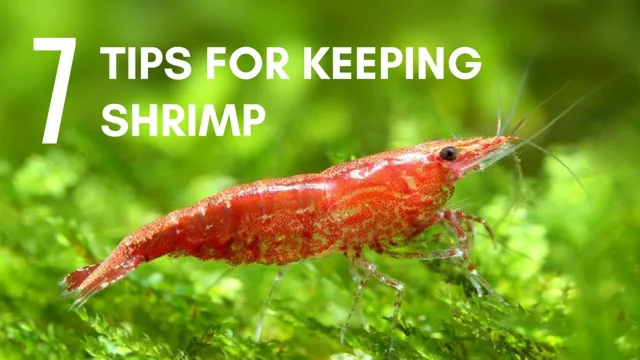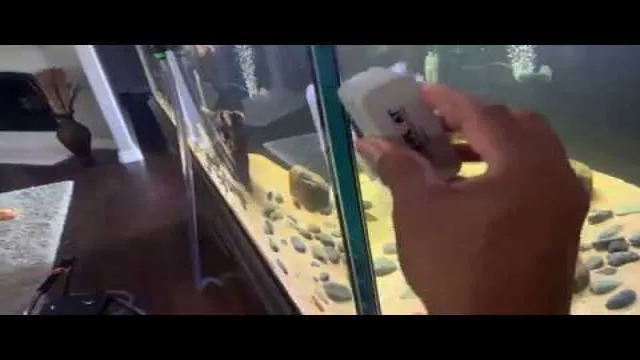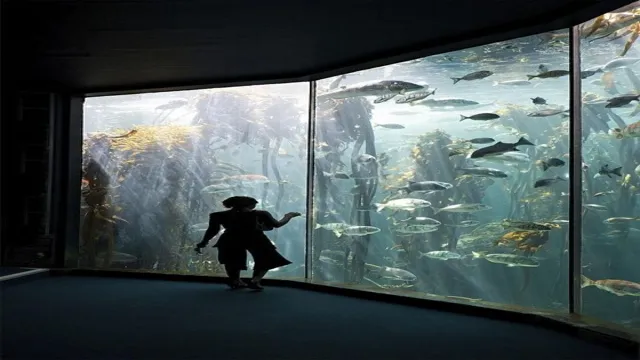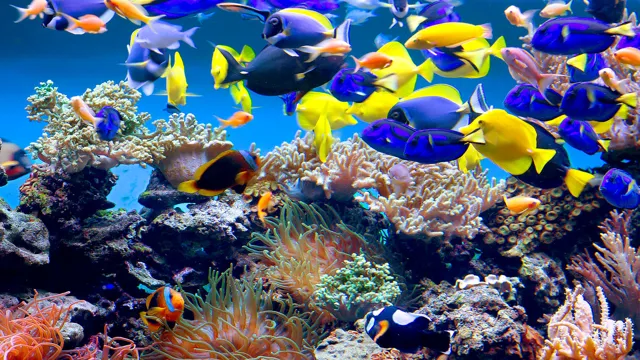Welcome to the beginner’s guide to creating a shrimp aquarium! If you’re new to the world of aquariums, there’s nothing more captivating than watching a school of tiny, colorful shrimp swimming around in their own miniature underwater ecosystem. But where do you start? What equipment do you need? How do you care for the shrimp to keep them healthy and happy? In this blog, we’ll walk you through all the essential steps of setting up your very own shrimp aquarium. We’ll cover everything from selecting the right tank, substrate, and décor, to choosing the ideal species of shrimp, feeding schedules, and maintenance routines.
Creating a thriving shrimp aquarium requires the right balance of art and science. You’ll need to be both creative in your design choices and meticulous in your attention to detail. But don’t worry – we’ll guide you through every step of the process, providing tips and tricks to help you navigate the sometimes-challenging waters of aquarium keeping.
Whether you’re a seasoned fish-keeper looking to expand your collection, or a complete beginner looking to explore the world of aquariums, this guide will provide you with all the information you need to create a stunning shrimp aquarium that will entertain and delight you for years to come. So, let’s dive in and start creating your very own underwater paradise!
Choosing the Right Tank Size and Equipment
When setting up a shrimp aquarium, it’s important to choose the right tank size and equipment for your crustacean companions. A general rule of thumb is to have at least 1 gallon of water for every inch of adult shrimp. So, a 10-gallon tank is suitable for 10 adult shrimp.
Additionally, you’ll need to consider the type of filtration system to use in your tank. Shrimp produce a lot of waste, so a filter with a gentle flow is best for their delicate nature. A sponge filter or a hang-on-back filter with a spray bar will do the trick.
Another vital piece of equipment is a heater, as shrimp require stable waters with temperatures ranging from 72°F to 80°F. Investing in a thermometer will help you regulate the temperature as needed. With the right tank size and equipment, your shrimp will thrive and bring a colorful element of aquatic life to your home.
Selecting a Tank Size
Selecting the correct tank size is essential when starting an aquarium, as it can affect the type and number of fish you can keep. A good rule of thumb is to have one inch of fish per gallon of water, however, this is a generalization and can vary depending on the fish species and their individual needs. It’s crucial to research and plan out what types of fish you’d like to keep and their minimum tank size requirements before selecting a tank.
You don’t want to end up with a tank that’s too small, as this can lead to overcrowding, decreased water quality, and potential health issues for your fish. Additionally, it’s essential to invest in proper equipment such as filters, heaters, and lighting that match the size of your tank. A larger tank will require more powerful equipment to maintain proper water conditions.
Overall, selecting the right tank size and equipment is critical for creating a healthy and thriving aquatic environment for your fish.

Picking Essential Equipment
When it comes to setting up an aquarium, choosing the right tank size and equipment is crucial for the well-being of your aquatic pets. Tank size matters because it determines how many fish you can have and how comfortable they will be. As a rule of thumb, aim for a tank that can hold at least one gallon of water per inch of fish.
So, if you plan on keeping a few small fish, a 10-gallon tank should suffice, while larger fish or more fish will require a bigger tank. As for equipment, the most essential items are a filter, heater, and lighting. A filter is crucial for maintaining the water quality by removing waste and debris, while a heater helps to regulate the temperature.
Lighting is also important as it helps to promote the growth of beneficial bacteria and can enhance the color of your fish. With the right tank size and essential equipment in place, your aquarium will be a healthy and thriving environment for your aquatic pets.
Adding Substrate and Decor
When it comes to setting up a new aquarium, choosing the right tank size and equipment is crucial for the well-being and happiness of your fish. While it can be tempting to opt for a smaller tank to save money or space, keep in mind that overcrowding can lead to stress and health problems for your aquatic pets. On the other hand, a tank that’s too large can be difficult to maintain and unnecessary for smaller species.
Consider the types of fish you plan to keep, as well as their adult size and behavior, to determine the appropriate tank size. As for equipment, investing in a good filter, heater, and lighting system is essential for regulating water quality, maintaining proper temperature, and promoting plant growth. Don’t forget to also choose substrate and decor that are specifically designed for aquariums and won’t harm your fish.
With the right tank size and equipment, you can create a safe and comfortable home for your aquatic friends to thrive in. (See Also: How to Get Rid of Freshwater Snails in Aquarium: Effective Strategies and Prevention Tips)
Cycling Your Tank
One essential step in creating a successful shrimp aquarium is cycling your tank. Cycling the tank refers to the process of establishing beneficial bacteria that will break down harmful toxins like ammonia and nitrite, which can be deadly for shrimp. To start the process, add a source of ammonia to the tank, like fish food or pure ammonia, and monitor the water parameters using a test kit.
As the bacteria begin to establish, ammonia and nitrite levels will spike, but eventually, they will drop to zero as nitrate levels increase. This process can take anywhere from a few days to several weeks, depending on the size of the tank and the amount of ammonia added. Once the water parameters stabilize, you can start adding shrimp to your newly cycled tank.
Cycling your tank is a crucial step that cannot be skipped, as it helps ensure a healthy and thriving ecosystem for your shrimp.
What is Aquarium Cycling?
Aquarium cycling is the process of establishing a healthy ecosystem in your tank before adding any fish or other aquatic animals. This is done by growing and nurturing beneficial bacteria that help break down harmful chemicals such as ammonia and nitrites that can be deadly to fish. Cycling your tank involves adding a source of ammonia, like fish food or pure ammonia, to your tank and allowing the bacteria to develop naturally over time.
This can take anywhere from a few weeks to several months, depending on the size of your tank and the number of fish you plan on adding. Once the beneficial bacteria are established, you can test the water parameters to ensure they are within safe levels before adding your fish. Proper cycling of your aquarium is crucial for the health and longevity of your fish and other aquatic animals.
By taking the time to cycle your tank, you are creating a healthy and stable environment for your aquatic pets to thrive in.
How to Cycle Your Tank for Shrimp
Cycling your tank is an essential step before adding shrimp to your aquarium. It involves creating a healthy and stable environment for your shrimp to thrive in. To cycle your tank, you need to introduce beneficial bacteria that will break down toxic waste produced by your shrimp.
There are several ways to cycle your tank, but the most popular one is the fishless cycle. Instead of adding fish to your tank, you can add ammonia to create an environment that promotes bacterial growth. As the bacteria break down the ammonia, they produce nitrite, and eventually, nitrate.
The process can take up to six weeks, and it’s essential to regularly test the water parameters to ensure they remain within safe levels for your shrimp. Once the process is complete, your tank will be ready to house your shrimp. Remember to go slow and not add too many shrimp at once, as overcrowding can cause stress and even death to your new pets.
With patience and proper care, your shrimp will be happy and healthy in their new home.
Monitoring Your Water Parameters
Cycling your tank is one of the most critical steps when setting up an aquarium. Essentially, it refers to the process of establishing the necessary bacteria in the tank to convert harmful waste products into less harmful ones. This process can take anywhere from a few weeks to a few months, and it’s essential to monitor your water parameters regularly during this period.
You’ll want to check your ammonia, nitrite, and nitrate levels at least once a week and keep a record of your results. That way, you’ll be able to track the progress of your tank’s cycle and take steps to address any issues that arise. Remember, a properly cycled tank is crucial for the health and wellbeing of your fish and other aquatic life, so it’s essential to be patient and thorough during this process.
Choosing the Right Shrimp
When it comes to creating a shrimp aquarium, choosing the right shrimp is crucial to its success. There are many different types of shrimp to choose from, each with their own unique characteristics and care requirements. Some popular options include cherry shrimp, crystal shrimp, and ghost shrimp. (See Also: How to Lower Nitrites in Aquarium Water: A Comprehensive Guide)
It’s important to do your research and choose a shrimp breed that is compatible with your tank’s water parameters and other inhabitants. Additionally, make sure to consider the size of the shrimp as they grow, to ensure they have enough space to thrive in the aquarium. By carefully selecting the right type of shrimp and providing them with a suitable environment, you can create a beautiful and thriving shrimp aquarium that is sure to bring joy and serenity to your home.
Different Types of Shrimp
When it comes to choosing the right shrimp, there are a few types you should consider. First, there’s white shrimp, which is the most commonly found type of shrimp in grocery stores and restaurants. White shrimp have a mild flavor and are great for boiling, frying, or grilling.
Then there’s brown shrimp, which have a sweeter, more robust flavor than white shrimp. They’re often used for dishes that require a stronger shrimp taste, like gumbo or jambalaya. Finally, there’s pink shrimp, which are also known for their delicate taste and texture.
They’re usually smaller than other types of shrimp and are often found in cold-water environments. Overall, the type of shrimp you choose depends on the dish you’re making and your personal taste preferences. Whether you go for white, brown, or pink shrimp, make sure to look for sustainably sourced options to protect the environment and ensure the highest quality taste.
Selecting Compatible Tank Mates
When selecting tank mates for your shrimp, it’s important to choose ones that are compatible with their specific needs. Not all shrimp are the same, so it’s crucial to do your research before adding any new species to your tank. One great choice for a shrimp tank mate is the snail.
Snails are peaceful creatures that won’t disturb your shrimp, and they will help keep your tank clean by eating up any leftover food or algae. Another great option is the dwarf crayfish. These tiny creatures won’t harm your shrimp, and they add a unique element of interest to your tank.
However, it’s important to note that not all crayfish are compatible with shrimp, so be sure to choose the dwarf variety specifically. Overall, when it comes to choosing the right shrimp tank mates, do your research and choose peaceful species that won’t cause harm and can happily coexist in your tank.
Feeding and Maintaining Your Shrimp
If you’re interested in starting a shrimp aquarium, understanding how to feed and maintain your new pets is key. Shrimp are scavengers, so they will eat just about anything they can find in their environment. However, it’s crucial to provide them with a high-quality diet to ensure their health and wellbeing.
You can feed your shrimp a variety of foods, including algae wafers, shrimp pellets, and even small bits of vegetables like zucchini or spinach. It’s important not to overfeed your shrimp, as excess food can lead to water quality issues. In addition to feeding, maintaining your shrimp aquarium also involves regular water changes and keeping an eye on the pH level to ensure optimal conditions.
By carefully monitoring and taking care of your shrimp, you can enjoy a thriving and beautiful aquarium for years to come.
Feeding Your Shrimp
When it comes to feeding your shrimp, it’s crucial to provide them with a balanced diet to maintain their health and well-being. Commercially available shrimp pellets or flakes are a great option, but you can also supplement their diet with fresh veggies, such as blanched spinach or zucchini. Just be sure to remove any uneaten food within a few hours to prevent water quality issues.
It’s also important to maintain the cleanliness of their tank by regularly performing water changes and keeping up with proper filtration. This ensures that your shrimp have a healthy environment to thrive in and can make a huge difference in their overall health and longevity. By prioritizing their diet and tank maintenance, you can keep your shrimp happy and healthy for years to come.
Cleaning Your Tank
Cleaning your tank is an essential part of maintaining a healthy environment for your shrimp. The first step is to remove any uneaten food or debris from the tank. You can use a gravel vacuum, sponge filter, or syphon to remove the debris.
Next, you should consider doing a partial water change to remove any excess waste that may be present. When doing this, it’s important to use water that is the same temperature as the water in the tank to avoid shocking your shrimp. Also, be sure to treat the new water with a dechlorinator to remove any harmful chemicals. (See Also: How to Keep the Aquarium Water Crystal Clear: Top Tips for an Optimal Aquarium Environment)
Finally, give your tank a good wipe down to remove any algae or biofilm that may have accumulated. A clean tank ensures healthy shrimp, which means less stress and a longer lifespan for your little critters!
Conclusion
In conclusion, creating a shrimp aquarium is like building a tiny, underwater kingdom for your crustacean companions. From choosing the perfect tank size and substrate, to selecting the right aquatic plants and decorations, every step is crucial to ensure a happy and healthy shrimp community. Like all good rulers, you must also maintain their kingdom by monitoring water parameters and performing regular tank maintenance.
But with a little patience and TLC, you’ll soon be amazed at the colorful and fascinating world you’ve created. So why not dive in and make a splash with your very own shrimp aquarium?”
FAQs
What type of shrimp can be kept in an aquarium?
There are several types of shrimp that can be kept in an aquarium, including cherry shrimp, ghost shrimp, and amano shrimp.
How big of an aquarium is needed for shrimp?
Shrimp can be kept in small aquariums, as small as 5 gallons, but it is recommended to have at least a 10 gallon tank for a small group of shrimp.
What type of substrate is best for a shrimp aquarium?
Shrimp prefer a fine-grained substrate, such as sand or flourite. It is important to avoid sharp or rough substrates that can harm the shrimp.
What temperature should a shrimp aquarium be kept at?
Shrimp usually prefer a temperature range between 72-82 degrees Fahrenheit, depending on the species.
Can shrimp live with other fish in an aquarium?
Yes, shrimp can often be kept with peaceful fish such as guppies, tetras, and rasboras. However, it is important to avoid adding any aggressive or predatory fish that may harm or eat the shrimp.
How often should the water be changed in a shrimp aquarium?
It is recommended to do a partial water change of 10-20% every week to maintain good water quality for the shrimp.
What type of plants are good for a shrimp aquarium?
Shrimp prefer densely planted aquariums with lots of hiding spaces, so plants such as java moss, anubias, and hygrophila can be good choices. It is important to avoid any plants that may release toxins harmful to the shrimp.







